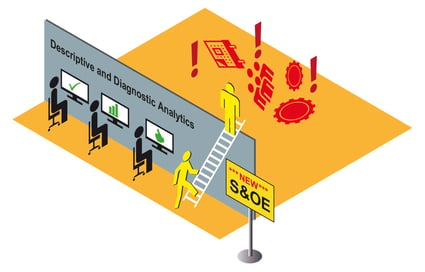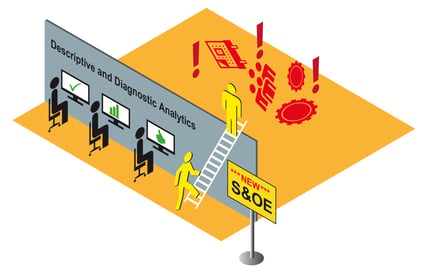Dissecting the True Value of S&OE
Brian Hoey - March 20, 2018

 Imagine for a moment that you are the supply chain planner for a company that manufactures parts for automotive production with major clients overseas in Asia. To save money on shipping costs, you accept the long lead times associated with ocean shipping over air freight and send a large shipment of parts by boat. Once the parts have already been shipped, your demand planners revise their demand estimates and it becomes necessary to ship a large number of parts by air at great expense in order to meet the new demand estimate. By not assessing demand accurately before shipping, your company has left significant value on the table and incurred significant additional shipping costs.
Imagine for a moment that you are the supply chain planner for a company that manufactures parts for automotive production with major clients overseas in Asia. To save money on shipping costs, you accept the long lead times associated with ocean shipping over air freight and send a large shipment of parts by boat. Once the parts have already been shipped, your demand planners revise their demand estimates and it becomes necessary to ship a large number of parts by air at great expense in order to meet the new demand estimate. By not assessing demand accurately before shipping, your company has left significant value on the table and incurred significant additional shipping costs.
Even with the rise of a more connected global supply chain, situations like these are far from uncommon—largely because of a gap between sales and operations planning (S&OP) and the daily execution of value chain processes like production and shipping. To bridge this gap, some companies have been turning toward a new type of business process that Gartner has termed sales and operations execution (S&OE), a function designed to give a daily or weekly snapshot of a company’s actual, real-time demand picture. The true value of this process, however, extends far beyond its explicit relationship with operational planning.
Combating Volatility
One of the most significant value added benefits of adopting S&OE principles in your demand and production planning processes is an overall decrease in supply chain risk and volatility. By taking a holistic view of a given business’ supply chain operations, S&OE can respond to small daily and weekly demand fluctuations in order to keep longer-term operational and strategic plans on track. Instead of experiencing a large accumulated gap between expected and real demand and production output at the end of each quarter, companies find that their expectations and production output have undergone subtle shifts over time to track with real-time demand information.
Not only does this process increase the agility of a given supply chain, ensuring that orders are met on-time more consistently and that customer satisfaction is improved, it also prevents overcorrections in response to apparent disruption, i.e. inventory overages following earlier shortfalls, or early parts deliveries with unused freight capacity. While disruptions in the a complex global supply chain are inevitable, small adjustments and course corrections can greatly mitigate their effects, not only decreasing the extent to which unexpected supply chain events can wreak havoc on a business’s operations, but also the extent to which overreactions can create endemic risks within existing value streams.
Visibility
While execution’s stated purpose is carrying out the tasks described above, its mere existence can help to drive intra-operational improvements that align with emerging Industry 4.0 principles. Specifically, with windows into real-time demand and deviations from forecasts and production schedules, the execution process can help to increase supply chain visibility throughout a given organization. Because S&OE requires real-time data and a high level of information transparency, companies that adopt such workflows necessarily drive towards a greater degree of internal and external visibility. As a result, weaknesses in the supply stream that had previously been obscured by siloes will quickly become apparent; inefficiencies throughout all parts of a company’s production program and supply network will be laid bare for supply chain planners to asses and remedy.
In the example of the last minute demand changes above, the added value of increased visibility isn’t difficult to identify. Not only would real-time demand information have improved planning accuracy in spite of the long shipping lead times, it would have given demand planners a window into existing production and shipping capacity restrictions, enabling a more synergistic relationship between disparate planning functions.
Reporting and Analytics
Sales and operations execution certainly derives the majority of its unique business value from its ability to keep mid-term operational plans on track in order to better meet customer demand and generate revenue. Beyond this crucial business function, however, its impact can be harder to quantify, in part because it can become an important pillar of broader organizational improvements that can bring one’s operations more in line with emerging principles surrounding Industry 4.0 and intelligent manufacturing. To take just one example, S&OE has become, for many organizations, the backbone that supports the widespread integration of advanced analytics. By driving increased data visibility, sales and operations execution paves the way for sophisticated analytics software to be trained on a company’s data, leading to a number of potential benefits:
- Improved forecasting and demand predictions
- Proactive maintenance downtime scheduling to reduce disruptions
- Automated data visualizations and suggestions for improvements to the value chain.
In this way, bridging the gap between planning and execution becomes a crucial value driver, pushing variant rich manufacturing operations towards ever leaner and smarter supply chains.
LATEST POSTS
- Understand Circular Economy in The Manufacturing Industry
- How Can Industry 4.0 IT Integration Be Achieved Smoothly?
- The Significance of Order Sequencing in Discrete Manufacturing
- How to improve your Supply Chain Management: The Power of Control Towers
- Optimizing Human Resource Scheduling in Manufacturing: A Technological Approach



